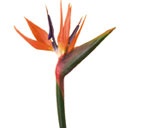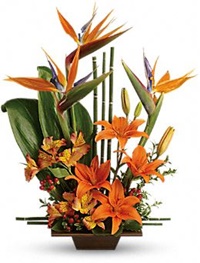
The exotic and beautiful Bird of Paradise flower is named so for its unusual bird-like appearance when in bloom. Many designers and flower aficionados believe the blossoms resemble the head and plumage of a crane. This flower is a favorite among horticulturists and can be found growing in gardens everywhere. In the wild, however, the plant’s range is limited to the subtropical terrain of South Africa, between KwaZulu-Natal province in the southeast and the south-central Eastern Cape province.

A history of the crane flower
The Bird of Paradise is also known as the crane flower and the Strelitzia Reginae, and was discovered in the late 1770s by Scottish botanist Francis Masson. He worked for the Royal Gardens at Kew. Masson traveled to South Africa and gathered native plants to bring back to exhibit at the Royal Gardens. He sent hundreds of specimens back to the Gardens, one of which was was a Bird of Paradise. In 1773, the unofficial director of the Gardens, English botanist Sir Joseph Banks, introduced the amazing plant to Britain. He gave it the name Strelitzia after Charlotte of Mecklenburg-Strelitz, queen consort of George III.
Shop for Exotic Grace Bird of Paradise Arrangement

Exotic Grace Bird of Paradise Bouquet
The structure of the plant
The Bird of Paradise is classified in the same order of flowering plants as ginger, banana and their relatives. The fiery flower grows to about 3 to 4 feet in height and has clumps of stiff banana-like leaves that are gray to green in color, extending up from its base. The bright flowers sprout from a beak-like structure known to aficionados as the spathe, which rests at the top of a long stalk and forms a sheath that protects the bloom. The color of the spathe can range from green to purple.
A beautiful bloom
The stunning flowers usually appear in mid-winter and open in succession, with the first ones opening in spring. Each flower is made up of three bright orange upright petals and three bold blue petals. At the base of the flower where two of the petals join together is the nectary, where nectar is secreted. When thirsty birds like the amethyst sunbird or the double-collared sunbird land on the flower to drink the nectar, the petals open and pollen becomes attached to the birds’ feet.
When the birds transfer pollen from one Bird of Paradise flower to another, pollination is complete. During fertilization, the seeds that form evolve into small fruits, which split open and expose the seeds. Those seeds are eaten by birds, and are scattered in new areas, helping the plant maintain its distribution across its habitat.
Growing your Bird of Paradise
First, you should find an ideal spot for your flower. If you live in a climate that has temperatures that dip below 50 degrees Fahrenheit, the plant can stay outside during warmer temperatures and be brought indoors when it gets cold. Birds of Paradise thrive in spots that receive full sun and they prefer loamy, rich, well-drained soil.
As you plant, leave at least 6 feet between each plant if you are growing multiple Birds of Paradise because they will need adequate room to flower. Soak the plant with water before planting it into the hole or moving it into a pot.
Remove dead leaves and diminishing flowers to reduce the chance of fungus, and fertilize the plant with a 3:1:5 fertilizer or compost during the spring months before it begins new growth.
Source: Teleflora – Exotic Flower Spotlight: All About Birds of Paradise





